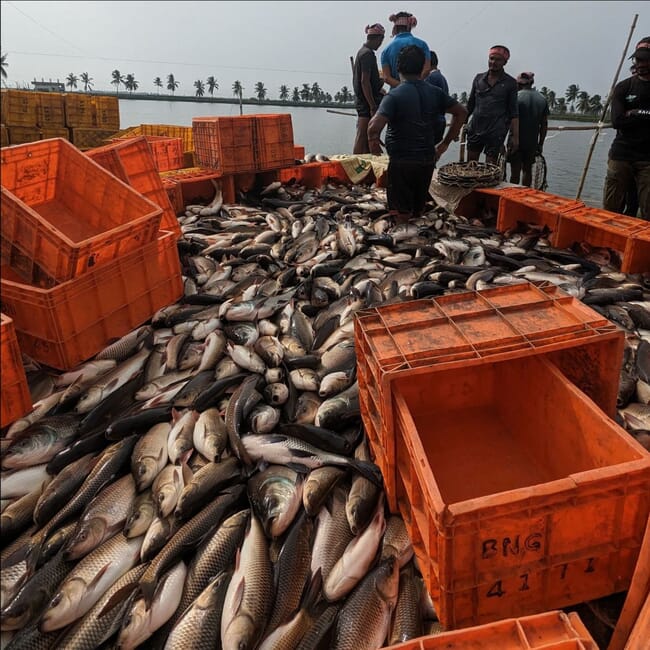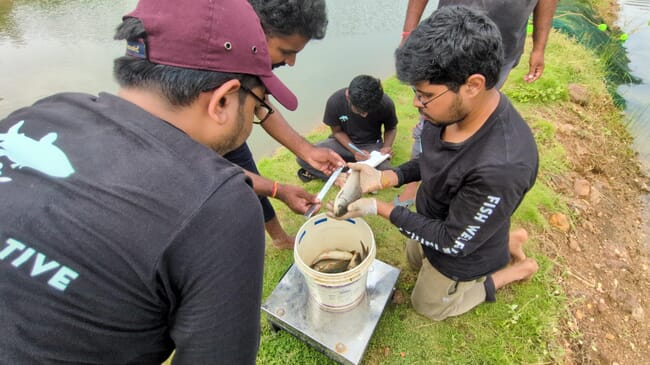
Many of the individual fish were still alive when this was taken, and will take up to a few hours to asphyxiate to death © Fish Welfare Initiative
Interested researchers are encouraged to respond to the charity’s request for proposals (RFP) by 1 December.
Haven King-Nobles, co-founder and executive director of the NGO, explains the motivation behind the project: “When driving through certain regions of Andhra Pradesh, one can’t help but notice the fish and shrimp farms that line the roads on both sides. Spend enough time travelling around, and you’re likely to witness a fish harvest—a process where the fish are captured using a large dragnet and left in the open air to asphyxiate before being packed and transported.
“From an animal welfare perspective, this is a troubling sight. Although research on the specific welfare needs of Indian major carp is limited, extensive studies on other species—and basic intuition—suggest that suffocating to death over several minutes or even hours is a deeply distressing way to die.”
However, he is aware that the challenges to implementing stunning are numerous.
“There are certainly significant challenges to developing this technology in India: infrastructure, lack of apparent consumer demand, and lack of species-specific parameters, to name a few. For this reason, we’re not looking to immediately develop stunning equipment, and will only later do so if it seems viable. However, we do believe the time is right to begin exploring the viability and possible early adopters of this technology, and that is what this RFP is all about.”
In search of the right researchers
The RFP is open to researchers both within India and internationally, though those with knowledge of the Indian aquaculture industry will be preferred.
“We’re primarily looking for researchers within India, though are open to international researchers or teams who have some experience in the country. We’re also looking for researchers who can research on the intersection of social sciences and aquaculture—for instance, we want them to identify which industry stakeholders might be amenable to stunning tech, and why,” explains King-Nobles.
In addition to the research focus, Fish Welfare Initiative sees this project as a valuable opportunity for rising researchers.
“We think this could be a really promising project for up-and-coming aquaculture researchers, especially those who are excited to bring innovation to the sector in India,” King-Nobles adds.
Fish welfare in India
The broader importance of this initiative becomes clear when considering the welfare of the animals involved. Vivek Rachuri, FWI’s R&D senior project manager, spends a lot of time working with these animals on the ground and stresses the need to empathise with them.
“When I want to get people to care about this issue, I ask them to imagine that they themselves were locked in a smoke-filled room, where they couldn’t breathe. Just like they might feel suffocation in such a scenario, I want them to imagine what it might be like for these fishes to suffocate outside of their own liveable environment,” he reflects.

Vivek Rachuri (right), FWI’s R&D senior project manager, measures a rohu carp as part of an ongoing feed fortification study. © Fish Welfare Initiative
Beyond the welfare benefits, Fish Welfare Initiative believes that India’s innovation culture makes it an ideal place to explore solutions like pre-slaughter stunning.
“Startups are booming in the country nowadays. And there’s a particularly large amount of this innovation in food production technology. We believe we can leverage this ecosystem and use it for our goal of improving animal welfare in aquaculture,” Rachuri concludes.
Next steps
Researchers interested in responding to the request for proposals are encouraged to submit a research plan and budget that will address the initial target audience, incentives and barriers, and scalability mechanisms of developing stunning technology in India. The deadline for submissions is 1 December 2024.




